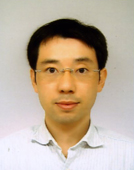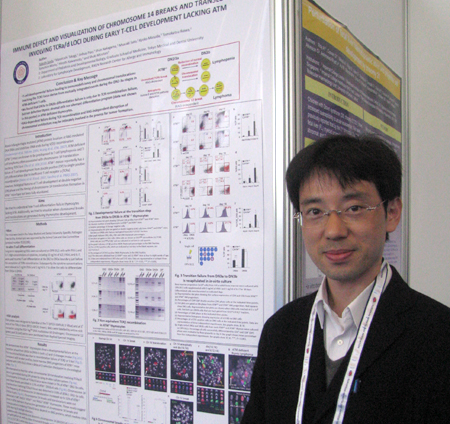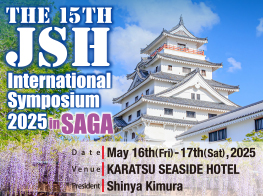
名前:磯田 健志【東京医科歯科大学 発生発達病態学】
発表日時:2012年6月15日
発表形式:Poster
Title:
IMMUNE DEFECT AND VISUALIZATION OF CHROMOSOME 14 BREAKS AND TRANSLOCATIONS INVOLVING TCRα/δ LOCI DURING EARLY T-CELL DEVELOPMENT LACKING ATM
Authors:
Takeshi Isoda 1, Masatoshi Takagi 1, Jinhua Piao 1, Shun Nakagama 1, Masaki Sato 1, Kyoko Masuda 2, Tomokatsu Ikawa 2, Miyuki Azuma 3, Tomohiro Morio 1, Hiroshi Kawamoto 2, and Shuki Mizutani 1
Affiliations:
1 :Department of Pediatrics and Developmental Biology, Tokyo Medical and Dental University, Tokyo,Japan
2:Laboratory for Lymphocyte Development, RIKEN Research Center for Allergy and Immunology,Yokohama,Japan
3:Department of Molecular Immunology, Tokyo Medical and Dental Univerisity, Tokyo, Japan
Topics: Hematopoiesis, stem cells and microenvironment
Abstract:
Background
Ataxia telangiectagia mutated (ATM) protein localizes at RAG mediated DNA DSBs and stabilizes DNA ends during V(D)J recombination. ATM deficient (ATM-/-) mice are known to be predisposed to T-cell lymphopenia and T-cell lymphoma often associated with chromosome 14 translocation involving TCRd loci. ATM-/- mouse reportedly has a failure of T-cell development from double positive (DP) to single positive (SP) differentiation due to inefficient T-cell receptor α (TCRα) recombination. However, biological features of T-cell development at double negative (DN) phase and the timing of chromosome 14 translocation formation in ATM-/- mice have not been fully elucidated.
Aims
We tried to understand how T-cell differentiation fails in thymocytes lacking ATM. Additionally, we tried to visualize when clomosomal breaks and translocations are generated during thymocytes development.
Methods
We employed in vitro T-cell differentiation assay for obtaining metaphase spread from DN phase thymocytes. BM-progenitors were cultured on OP9-DLL1 cells with high-dose cytokine including Flt3-L, IL-7 and SCF. This culture condition halts T-cell differentiation at DN2-3a phase just before β-selection. Then, by reducing the concentration of Flt3-L and IL7, the differentiation arrest was released, leading to differentiation of thymocytes from DN3a to DN3b.
Results
We demonstrate that ATM-/- thymocytes show a developmental failure at the transition phase from DN3a to DN3b in both αβand γδ-lineages in-vivo.
Consistent with in-vivo profiles, bone marrow (BM) progenitors of ATM-/- mice cultured with OP9-DLL1 show a delay at β-selection checkpoint in chronological order. This transitional failure was due to recombination failure of TCRβ or δ loci.
We attempted to monitor when chromosome 14 translocation involving TCRa/d locus is generated during DN phase by using in-vitro culture system. Chromosome 14 breaks at TCRa/d locus were shown in 5% of ATM-/- DN2-3a cells, and these breaks persisted in 2.5% of ATM-/- DN3b-4 cells. Chromosome 14 translocation involving TCRa/d locus was detected in 0.8% of ATM-/- DN2-3a cells. The frequency of chromosome 14 translocation increased up to 11% of ATM-/- DN3b-4 cells. Chromosome 14 breaks and translocations were not detected in WT, RAG2-/-ATM+/- nor RAG2-/-ATM-/- thymocytes. These results suggest that in ATM deficient thymocytes generation of chromosome 14 breaks and translocations involving TCRa/d locus depend on RAG proteins, which mediate DNA DSB during b and gd selection.
Additionally aneuploidy and dicentric chromosome 14 (dic(14:14) ) with TCRVα amplification as well as sister chromatid breaks and translocations of chromosome 12 (t (12:14) ) were also observed in minor population of ATM-/- cells . These snapshots might capitulate the RAG independent process for TCRVα amplification by breakage fusion breakage cycle and formation of recurrent chromosomal translocation toward thymic lymphoma in ATM deficiency.
Summary/conclusions
Our findings provide the first evidence that T-lymphopenia and chromosomal translocations in ATM deficiency derive from shared events involving a defect of repair of Rag dependent DNA breaks during early T-cell development. For lymphomagenesis Rag independent chromosomal instability processes are additionally involved in ATM deficiency.
第17回EHAでの発表を終えて:
今回は、日本血液学会からのEHAトラベルアワードをいただき、2012年6月14日から17日にアムステルダムで開催された第17回EHAに参加させていただきました。
開催都市のアムステルダムは運河の町で、東京駅のモデルになったとされるアムステルダム中央駅を中心に、扇状に5本の運河が設置され、放射状に道が整備されています。屋根の形状が個性的ですが、建物の高さ、色調は茶色の煉瓦を中心に統一され、町を眺めるだけでも歴史を感じることができます。宿は中央駅付近に決めていたので会場のアムステルダムRAIには連日トラムで移動をしました。移動中は、運河沿いの建物の様子、アムスの心臓とよばれるダム広場では、戦没者慰霊棟、王宮、2002年に皇太子が結婚式を挙げた新教会を眺めることができました。
学会は、ASHと比較するとコンパクトで、時間帯で同一のsessionが開かれており、educationについては午前、午後の2回開催されておりました。主に小児科関連と白血病の分子生物学的話題を取り扱ったsessionを中心に拝聴しました。Educationでは、間葉系幹細胞、免疫不全症のトピック、EBV関連疾患、遺伝子治療の現状について確認することができました。印象に残った報告は、CMLにおけるbcr-ablに対するTKIだけでなく、suivivalに寄与するautophagyの経路をクロロキンで遮断しようとする試み、T-ALLにおけるRPL5,10などリボソーム関連遺伝子の変異報告、MDSにおけるcohesin complexの STAG2変異(こちらは、小川研の紺先生より)など、新規の遺伝子変異の同定、既知の分子でも治療の幅を広げようとする報告はたいへん刺激を受けました。
私自身の発表内容は、遺伝性毛細血管拡張性小脳失調症の責任遺伝子であるATMが欠損した時の、double negative(DN)期(CD4-CD8-)のT細胞分化を検討したものです。ATM欠損マウスのDN期プロファイルを見ていくとTCRβ 鎖再構成異常を主体としてDN3aから3bに分化障害があることが判明しました。この分化障害のタイミングは、同時にTCRδ鎖再構成も行われるため、リンパ腫で見られる染色体転座はこの時期に生じることを疑い、移行不良の前後で十分な分裂期標本を作成できる実験系を立ち上げました。これによりTCRδ鎖の切断、染色体転座の頻度を検証すると、DN2-3aで切断が生じ、DN3b-4に移行したところで染色体転座が生じることが判明しました。また、RAG蛋白に依存しない、染色体の異数性や、分裂期での染色体切断も観察され、段階的に染色体構造変化を伴う細胞を可視化して捉える事ができました。将来は、ヒトの系で応用すれば、AT患者さんでの新薬の検討につなげられる可能性があると考えています。本内容についてはポスターで報告を行い、座長の先生からはきれいな内容であることを評価いただきました。今後は、なぜbreakが入りやすいのか、そのメカニズムについて検討をしていきたいと考えています。
最終日には、今回のトラベルアワード受賞者の方々と集う機会があり、臨床と基礎と意識をされながら仕事に取り組まれていることを伺うことができました。私自身も微力ではありますが、小児科の視点から発信できることは何か意識しながら精進していきたいと感じております。今回、初めてのEHA参加が、同時に初めてのヨーロッパへの旅になりました。歴史と文化に触れる貴重な機会にもなりました。ASHとの違いは、ヨーロッパ各国の代表的な都市で開かれているようですから、新しい血液学の情報と合わせて、異文化の交流を楽しめることが醍醐味かと感じました。貴重な機会をご提供いただいたすべての皆様に心より感謝申し上げます。




